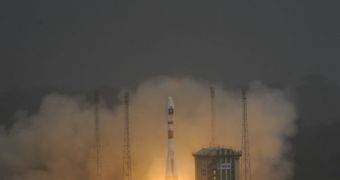The European Space Agency (ESA) successfully launched the first two satellites of its future satellite navigation constellation today, October 21. The spacecraft launched on time from the Kourou Spaceport ESA operates in French Guiana, South America.
The Galileo In-Orbit Validation satellites are designated PFM and FM2. They represent verification models, meant to test the viability of the overall design. Two more satellites will be launched in the coming month, in order to confirm that data from PFM and FM2.
If everything goes according to plan, ESA will then continue to launch 26 additional satellites, finally bringing its Galileo satnav system online within a few years. Europe develops this system as a response to the American-built Global Positioning System (GPS) network.
ESA was originally supposed to launch the two satellites yesterday, October 20, but a glitch with the Soyuz ST-B delivery system prevented the launch. Engineers at Kourou announced that they needed a day to fix the issue, and they can try over the night.
The rocket carrying PFM and FM2 finally launched today, October 21, at precisely 12:30:26 pm CEST (1030:26 GMT). The spacecraft are placed in a special orbital dispenser, which itself is placed inside a Fregat-MT upper stage.
Today's event will also mark another important milestone from the agency, namely the first time a Russian-built rocket takes off from South America. Today was also the first time a Soyuz rocket took off from somewhere other than the Baikonur and Plesetsk Cosmodromes, in Kazakhstan and Russia.
ESA finished constructing the facility this year, under a contract with the Russian Federal Space Agency (RosCosmos). The reason for doing this is so that Europe can launch its own satellites on Russian missiles from its own facility. This reduces the costs associated with bringing Galileo online.
After Soyuz reaches orbit, engineers will stop the thrusters on its third stage, while allowing the Fregat-MT upper stage to fire up its own engines. This will deliver the dispenser to an altitude of about 23,222 kilometers (14,430 miles).
Once here, the dispenser will fire up a series of small pyrotechnic charges, which will send the Galileo satellites in opposite direction. Mission managers will then spend the next few weeks testing, calibrating and analyzing the performances of the two spacecraft.
ESA is not the only agency currently building global satellite navigation networks. RosCosmos is itself augmenting its GLONASS constellation, while China is getting ready to start building the Beidou network.

 14 DAY TRIAL //
14 DAY TRIAL //